|
Books by
Jeffery Robenalt
|
|
In
the aftermath of President
Mirabeau Lamar’s ill-fated expedition to Santa Fe, his successor,
Sam Houston, did
his best to maintain an uneasy peace between Mexico and the Republic
of Texas. Houston even cautioned peace when Mexican dictator, Santa
Anna, retaliated by sending General Vazquez with a thousand troops
across the Rio Grande to occupy San
Antonio. An infuriated Texas Congress declared war on Mexico,
but Houston knew the nearly bankrupt republic was in no position to
fight a war. “Texas would defend itself if need be,” he stated
after vetoing the declaration, “but we must not attack.”
The political pressure on Houston to take action continued to mount
when Santa Anna again ordered the occupation of San
Antonio by General Adrian Woll. The French mercenary’s
twelve hundred soldiers not only occupied and plundered the old mission
town, but also fought a battle
at Salado Creek with the local militia and Texas Rangers under
the command of “Old Paint” Caldwell. Although heavily outnumbered,
the Texans gave an excellent account of themselves when the Mexicans
assaulted their positions dug in along the creek, killing and wounding
nearly three hundred of the enemy while suffering only one casualty.
However, it was an incident that occurred during the fighting
at Salado Creek that did much to force President Houston’s hand.
In response to Caldwell’s call for volunteers, Captain Nicholas
Dawson and 53 men from La
Grange and Fayette County attempted to fight their way to the
Salado through numerous Mexican
cavalry patrols. Eventually, the Texans were cut off and surrounded
only a few miles from the creek where they dismounted and took cover
in a mesquite thicket near the present site of Fort Sam Houston.
The Texans repulsed an initial cavalry charge, but the Mexicans stood
off and used their artillery to batter the volunteers into submission.
Ignoring any attempts to surrender, the Mexicans moved in and finished
off the wounded, taking few prisoners. In what was to be known as
the “Dawson Massacre,” thirty-six Texans were killed, fifteen
were taken prisoner, and two escaped to reach Caldwell. The prisoners
were marched away to Mexico City and then to Perote prison
in Vera Cruz.
Finally, on October 3, 1842, President Houston, bowing to the
inevitable, ordered General Alexander Somervell of Matagorda
County to take command of the militia and Texas Rangers he had called
to muster in San Antonio.
However, Houston wisely hedged on an all out invasion of Mexico when
he gave General Somervell orders to make a demonstration in force
along the border, and "only cross the Rio Grande if he thought
it could be done successfully." |
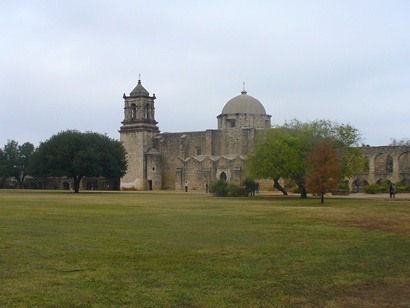 |
On
the 7th of November, 750 volunteers assembled at Mission San
Jose. The first task facing General Somervell was to move his small
army to a camp on the south bank of the Medina River and organize
the men into regiments and companies of infantry. Unlike the force
Caldwell had commanded at Salado
Creek, made up of local militia and a few Texas Rangers fighting
to protect their families and homes, many of Somervell’s undisciplined
adventurers had been lured from afar with rumors of loot and promises
of glory. The Texas Rangers commanded by Jack Hays were clearly an
exception. They would prove to be an invaluable asset to the General
during the trying times that lay ahead.
On November 25, the Rangers led the way south from the camp
on the Medina, their homemade flag proudly bearing the motto “We
give but ask no quarter” hanging limp in the pouring rain. The
expedition was short on powder, lead, beef, bread, and most other
supplies, and even lacked the wagons necessary to carry what little
they did have. The lack of wagons, however, was in all likelihood
a blessing because rain had been falling for several days and the
land that stretched between the Medina and the Frio River was a virtual
bog. |
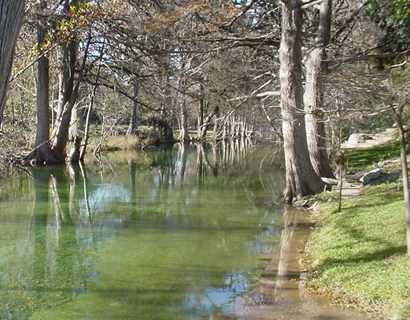 |
Three weary days
later, after slogging through miles of mud and standing water, the
column reached the Laredo Road and eventually forded the wide but
shallow Frio River on December 1. The raging flood waters
of the Nueces came next. When the Rangers rode ahead to scout
Laredo
, they were forced to undress and hold bundled clothes and weapons
high over their heads while their horses swam against the strong current.
Without the aid of a horse, swimming the river was next to impossible,
so Somervell ordered the construction of a crude bridge. The river
was quickly spanned and the volunteers were waiting on the south bank
of the Nueces when the Rangers returned from their scout three days
later.
General Somervell was surprised when Hays reported Laredo
undefended, and he immediately ordered a forced march to the Rio
Grande. By daybreak on December 8, the Texans were encamped
in a semicircle around Laredo.
Unfortunately, hours earlier, the alcalde had ordered more
than a thousand horses driven across the river out of the Texans'
reach, and Somervell's hope of mounting his entire force was lost.
|
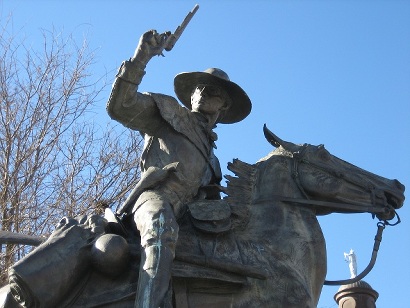 |
The Texans received
a silent greeting from the citizens of Laredo
when they entered town later that morning. Jack Hays personally hoisted
the Texas flag to the top of the church steeple. After demanding supplies
from the alcalde, Somervell pulled his men out of town and
relocated them three miles south on a hill near the Rio Grande. The
remainder of the day passed without incident, but well before sunrise
the following morning, more than two hundred men slipped out of camp
and headed for town.
Ignoring General Somervell’s direct orders to the contrary, the rowdy
volunteers looted Laredo,
taking what they pleased from the terrified citizens, including an
occasional unwilling daughter or wife. With the assistance of the
Texas Rangers, Somervell was eventually able to clear the town of
the undisciplined rabble and return most of the booty. However, much
to the alcalde’s annoyance, the General kept all the stolen
coffee, flour, sugar, and soap.
When the Texans pulled out of Laredo
the following day, Somervell decided to march down the east bank of
the Rio Grande to avoid the prying eyes of the Mexican cavalry. The
decision proved to be costly. Time and again mesquite thickets and
thorny chaparral forced the column to circle well away from the river,
and often there was no choice except to chop a path through the prickly
undergrowth. After six miserable days the volunteers were exhausted,
hungry, and practically out of supplies. That evening nearly 200 men
voted to return to San
Antonio.
The following morning, the remaining Texans crossed the Rio Grande
and advanced to Guerrero, some sixty miles below Laredo.
There Somervell gave the alcalde a choice; either hand over
100 hundred horses and five days’ provisions or the town would be
sacked. The Texans retreated back across the river to await the delivery
of the horses and supplies, but when the alcalde failed to
meet his demands in the morning, Somervell realized little could be
gained by sacking Guerrero. Whether they liked it or not, his men
were relatively safe on the Texas side of the Rio Grande and he intended
to keep them there.
On
the morning of December 19, General Somervell made a reluctant decision
to abandon the entire mission. The expedition would march north to
Gonzales where it
would be disbanded. As Somervell had expected, many of the men were
furious with his decision. William S. Fisher, one of the expedition’s
captains, asked for permission to continue the march down the river
with those men who were unwilling to disband, but Somervell denied
the request, warning of the dangers in such a move. |
| Ignoring the
General’s warning, 305 volunteers promptly resigned from his command
and elected Fisher to lead them in a private invasion of Mexico;
in actuality more of a quest for revenge and plunder than a military
action. Jack Hays and most of the Texas Rangers were among the 189
men who departed for Gonzales
in the early afternoon, but Rangers Sam
Walker and Bigfoot
Wallace made the decision to stay behind and join Fisher’s command. |
|
|
Captain
Sam Walker
wikipedia |
After consulting
with his officers, Fisher dispatched the Texas Rangers who
had remained with him down the Mexican side of the Rio Grande
with the dual mission of screening his force from the Mexican cavalry
and scouting the area around the town of Mier for any sign
of the enemy. The newly elected Colonel then marched the majority
of his small army south along the Texas
side of the Rio Grande, ferrying the remainder of the men down
the river on boats captured by the Rangers during the crossing to
Guerrero.
On December 22, the Texans marched into the Mexican town of
Mier unopposed. Colonel Fisher met with the alcalde
in the main Plaza, loudly demanding enough horses to mount his entire
force and sufficient provisions to feed the men for a week. As General
Somervell had before him, he threatened the town with destruction
if the horses and supplies were not delivered to the Texas
side of the Rio Grande by morning. However, unlike Somervell, Fisher
meant to keep his promise. Sensing the sincerity in the bitter tone
of Fisher’s words, the alcalde agreed to meet his demands,
and the Texans returned to their camp across the river. |
|
|
General
Pedro de Ampudia
wikipedia |
The Texans were
no sooner across the Rio Grande than Mexican General Pedro Ampudia
arrived in Mier with 3000 troops and refused to allow the alcalde
to deliver the promised supplies. Fisher was furious. Ignoring odds
of ten to one against him, he marched the Texans back to Mier
on December 24, and launched an immediate attack. The struggle
was close and bloody, but the outnumbered Texans fought their way
to the main plaza before nightfall.
The following day General Ampudia ordered three separate suicidal
charges across the plaza directly into the muzzles of the Texans’
rifles. In spite of being so heavily outnumbered, Fisher’s small army
held firm until shortages of water, food, powder, and lead finally
forced them to surrender the following morning. Only thirty-one Texans
were killed or wounded during the intense fighting while the Mexicans
suffered 200 wounded and nearly 600 killed. In an act of revenge for
their terrible losses, the Mexican soldiers stripped the bodies of
the dead Texans and drug them through the streets of Mier.
The survivors were marched in chains to Matamoros and then
on to Salado. On February 11, 1843, led by Sam Walker
and Bigfoot
Wallace, the prisoners managed a mass escape by disarming their
guards and overpowering the soldiers guarding the arms and ammunition.
Unfortunately, most of the Texans were soon lost, wandering for six
days in the mountainous desert north of Salado until they were nearly
dead from thirst and hunger. |
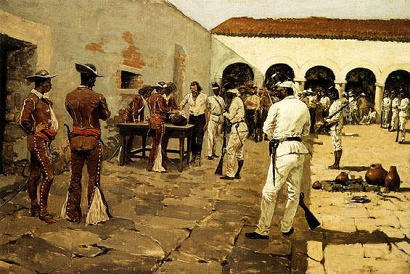 |
| Black
Bean Episode by Frederick Remington |
One hundred and
seventy-six prisoners were recaptured and marched to Saltillo
where Mexican President Santa Anna sentenced them to death en masse.
The harsh sentence was later commuted to death for one man in ten
at the urging of the American and British ambassadors. In what was
to later become known as the infamous “Black Bean Episode,”
the prisoners were forced to draw beans from a jar. The seventeen
men who drew black beans were stood against a wall and executed by
firing squad.
The remaining prisoners were marched to Mexico City where they
spent the summer laboring on a road gang. In September 1843, most
of the Texans were transferred to the infamous Perote Prison
in Vera Cruz, although some found their way into other Mexican
prisons. Over the course of the next year, a few escaped, including
Sam Walker who made his way to Tampico and managed to board a ship
for New Orleans. Many others died of wounds, disease, and starvation.
|
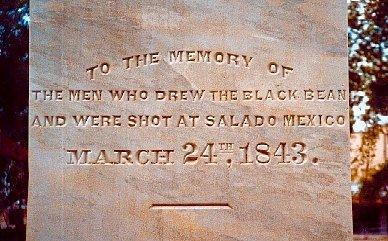 |
Monument Hill
Tomb Historical Marker
Photo courtesy Barclay
Gibson, February 2009 |
The 48-foot 1936
Centennial Monument marks the mass grave of the remains of the 1842
"Dawson Massacre" and the 1843 "Black Bean Death Lottery"
Photo courtesy Sarah
Reveley, February 2010 |
|
|
